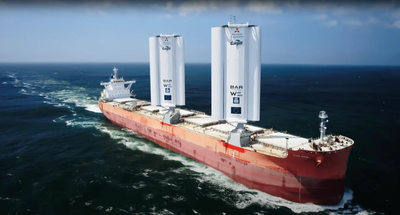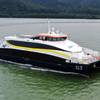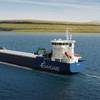Study Highlights Need to Reconsider Fixed Sea-Margin for Gate Rudder Concept
A study published by Norbert Bulten, Product Performance Manager at Wärtsilä, has demonstrated that “there is more in life than the straight-sailing, calm water condition.”
The research was carried out within the EU-funded CHEK project and involved full-scale CFD simulations that focused on the impact of rudder steering and vessel motion.
The study compared a gate rudder concept to a conventional semi-spade rudder for a Kamsarmax bulker.
Typically, a rudder is placed behind the propeller, where the movable part can be a part (semi-spade) or the complete rudder section (full-spade). The rudder profile sections can be pre-aligned with the incoming flow (twisted leading edge) or straight.
In contrast, the concept of a gate rudder has two symmetrical rudder parts located on either side of the propeller where the downstream, accelerated flow does not directly interact with the rudder. The rudder sections instead target a stagnation point of the flow close to the outer-side of the rudder leading edge. This creates a low-pressure region on the inner side of the gate rudder, which creates a net-thrust force. While both rudder parts are positioned at the same steering angle, their effect is balanced, but steering action changes this to create the desired force to steer the vessel.
Wärtsilä says its gate rudder reduces a vessel’s fuel consumption by replacing the drag of a traditional rudder system with a thrust-enhanced arrangement that also provides excellent manoeuvring capabilities and improves the noise and vibration signature. Placing the high-lift rudder foils on either side of the propeller enables turning at higher speeds and faster course changes.
As well as straight sailing, the CHEK project simulations included rudder steering, turning and drifting.
The study demonstrated that the rudders performed differently, and that propeller loading was influenced by vessel drift and turning. Vessel motion creates a pre-rotation of the flow to the propeller which influences the loading of the propeller when running at constant RPM. The paper states that the conventional performance evaluation of straight-sailing in calm water will not identify all actual performance aspects of the hull-propeller-rudder design and its interactions, which are required for Carbon Intensity Index (CII) regulations.
This will mean unprecedented change in vessel design, says Bulten, as traditionally it has been based on sea-trial performance with a sea-margin, typically 15%, added to power calculations to account for all operating conditions.
“Now the design of the hull and its main components will shift from design for sea-trial to design for operation. Due to this shift of focus, the concept of a fixed additional sea-margin needs to be reconsidered,” says Bulten in the paper.
The study was published in Ocean Engineering in October 2024, after the CHEK project concluded in May 2024.













